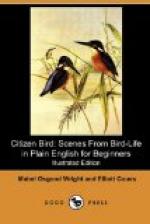A member of the guild of Ground Gleaners, who gleans its food industriously on beaches, and is very fond of the eggs of horseshoe-crabs.
The American Golden Plover
Length ten and a half inches.
In summer: Upper parts blackish, all spangled with yellow of the tint of old gold, white forehead and a line over the eye. Under parts nearly all jet black, but sides of the breast pure white, and lining of the wings gray. Tail barred with white and gray. Bill and feet black. Only three toes, there being no sign of a hind toe, which almost all Plovers also lack. Bill shaped like a Pigeon’s.
In winter: Without any pure black on the under parts, which are muddy whitish mixed and marbled with gray.
A Citizen of North America, whose summer home is with the Turnstone in the far North, and who travels to South America every fall and back again in the spring. We mostly see it in flocks on these journeys.
A member of the guild of Ground Gleaners, and a fine game bird, whose delicately flavored meat is a great luxury for invalids; it is therefore right for sportsmen to shoot Golden Plovers in the fall.
“Do tell us some more about paddling and wading birds,” said Dodo, forgetting that she was in her sopping-wet bathing-dress.
“Break—fast! Break—fast! Come in—come in—come in!” called the big bell that Rap’s mother was ringing at the cabin door. And the morning itself was hardly brighter than the smile on her face at the sight of her lame boy’s happiness. “Hurry along and dress, you little Sandpipers, for by and by we are going up the river,” said the Doctor.
“Why do you call us Sandpipers, Uncle Roy?” asked Nat.
“Because Sandpipers are long-legged little birds that run along the water’s edge, where they patter about and whistle, but can’t swim.” And they all raced laughing up to the cabin, Rap saying cheerfully, “Then I’m not a Sandpiper, for I hop like a Robin instead of running.”
In the afternoon, Olaf had the sharpie (which is a flat sharp-nosed boat with two masts) ready with a little dingey tied on behind, and when the tide rose the party went aboard. First he headed well out into the bay, and then tacked to enter the river where the channel was deepest. The river, which was the same that ran through the woods above the Farm, was caught in a corner to make the mill-pond, and finally escaping, ran along for many miles until the bay opened its wide arms to receive it.
“What are those birds over there?” cried Nat, pointing toward the outer beacon. “Some look like white Crows, and the others go zigzag like big Barn Swallows. Are there any such things as water Swallows, Uncle Roy?”
“Not exactly—both the birds you see belong to the Swimmers. The larger ones are Herring Gulls, and the smaller ones are Terns. But your guess is not a bad one, for all Terns are also called Sea Swallows, because of their dashing flight. Both Gulls and Terns nest on Gull Island, where Olaf is going to take us some day when the water is smooth. The storm has driven some of them into the bay, where they do not usually come until later in the year; but in winter great flocks of Gulls live about our beach, clamming on the bar at every low tide.”




